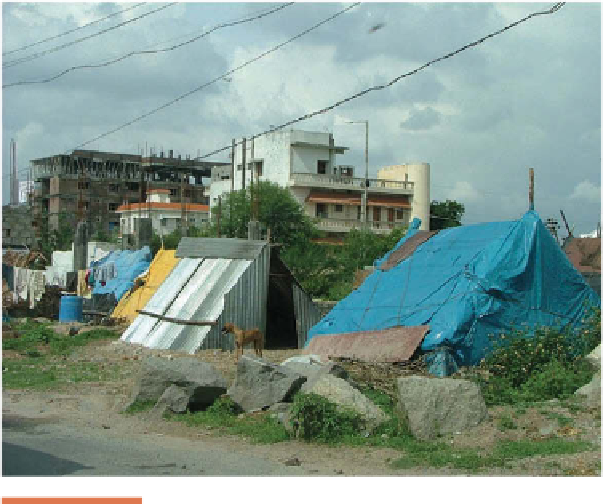Geography Reference
In-Depth Information
Cities in poorer parts of the world generally lack
enforceable
zoning laws.
Without zoning laws, cities in
the periphery have mixed land use throughout the city. For
example, in cities such as Madras, India (and in other cities
in India), open space between high-rise buildings is often
occupied by squatter settlements (Fig. 9.31). In Bangkok,
Thailand, elementary schools and noisy, polluting facto-
ries stand side by side. In Nairobi, Kenya, hillside villas
overlook some of Africa's worst slums. Over time, such
incongruities may disappear, as is happening in many cit-
ies in East Asia. Rising land values and greater demand for
enforced zoning regulations are transforming the central
cities of East Asia. But in South Asia, Subsaharan Africa,
Southwest Asia, North Africa, and Middle and South
America, unregulated, helter-skelter growth continues.
Across the global periphery, the one trait all major
cities display is the stark contrast between the wealthy and
poor. Sharp contrasts between wealthy and poor areas can
be found in major cities all over the world—for example,
homeless people sleeping on heating grates half a block
from the White House in Washington, D.C. Yet the inten-
sity and scale of the contrast are greater in cities of the
periphery. If you stand in the ce
Figure 9.31
Hyderabad, India.
Temporary shelters, built to withstand the
summer monsoon, protect the migrants who work to build the
new construction in the background.
ntral area of Cairo, Egypt,
you see what appears to be a modern, Mediterranean
metropolis (Fig. 9.32). But if you get on a bus and ride it
toward the city's outskirts, that impression fades almost
immediately as paved streets give way to dusty alleys,
apartment buildings to harsh tenements, and sidewalk cof-
fee shops to broken doors and windows (Fig. 9.33). Traffi c-
choked, garbage-strewn, polluted Cairo is home to an esti-
mated 12.5 million people, more than one-fi fth of Egypt's
population; the city is bursting at the seams. And still
people continue to arrive, seeking the better life that pulls
countless m
© Erin H. Fouberg.
neighborhoods became increasingly rundown because
funds were not available for upkeep or to purchase homes
for sale.
Before the civil rights movement, realtors could pur-
posefully sell a house in a white neighborhood at a very low
price to a black buyer. In a practice called
blockbusting,
realtors would solicit white residents of the neighborhood
to sell their homes under the guise that the neighborhood
was going downhill because a black person or family
had moved in. This produced what urban geographers
and sociologists call
white fl ight
—movement of whites
from the city and adjacent neighborhoods to the outly-
ing suburbs. Blockbusting led to signifi cant turnover
in housing, which of course benefi ted real estate agents
through the commissions they earned as representatives
of buyers and sellers. Blockbusting also prompted land-
owners to sell their properties at low prices to get out of
the neighborhood quickly, which in turn allowed devel-
opers to subdivide lots and build tenements. Typically,
developers did not maintain tenements well, dropping the
property values even further.
Developers and governments are also important
actors in shaping cities. In cities of the global core that
have experienced high levels of suburbanization, people
have left the central business district for the suburbs for
a number of reasons, among them single-family homes,
yards, better schools, and safety. With suburbanization,
city governments lose tax revenue, as middle- and upper-
class taxpayers leave the city and pay taxes in the suburbs
instead. In order to counter the suburbanization trend,
igrants from the countryside year after year.
Shaping Cities in the Global Core
The goals people have in making cities have changed
over time. One way people make cities is by remaking
them, reinventing neighborhoods, or changing layouts to
refl ect current goals and aesthetics. During the segrega-
tion era in the United States, realtors, fi nancial lenders,
and city governments defi ned and segregated spaces in
urban environments. For example, before the civil rights
movement of the 1960s, fi nancial institutions in the busi-
ness of lending money could engage in a practice known
as
redlining
. They would identify what they considered
to be risky neighborhoods in cities—often predominately
black neighborhoods—and refuse to offer loans to anyone
purchasing a house in the neighborhood encircled by red
lines on their maps. This practice, which is now illegal,
worked against those living in poorer neighborhoods and
helped to precipitate a downward spiral in which poor











































